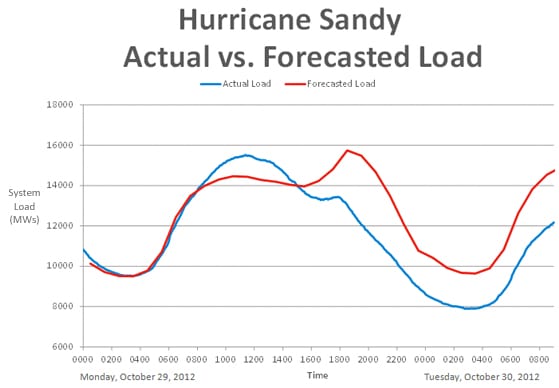New England grid operations through Hurricane Sandy; preparation and communication key
On October 29, 2012—exactly a year to the day after an unprecedented snow storm hit New England—Hurricane Sandy pummeled the region, giving folks yet another reminder that severe weather can strike at any time.
Hurricane Sandy showed little mercy, with reports of wind gusts in some areas of New England reaching 70+ miles per hour and driving rain that caused flooding and record ocean storm surges. Widespread and scattered power outages affected all six states, but the majority of outages were in low-lying and coastal areas of New England, including the Connecticut shoreline, parts of Rhode Island, and eastern Massachusetts. The total number of customers without power at the peak late Monday night was estimated to be more than 1.3 million. At the time of this article’s publication, two days after the storm, about 610,000 customers remain without power.
|
Sandy by the numbers
|
Early detection, advanced preparation
More than a week before Sandy’s arrival in the region, the electric industry had its eye on the storm. While Sandy’s path was uncertain, its effects would surely be felt in New England. This early detection allowed the ISO, utility companies, generation owners, and customers to make necessary preparations in advance of the storm.
In the week before the storm’s landfall, the ISO began communicating about the potential impacts of the hurricane with regional transmission owners, generator owners, and local control centers to coordinate plans for operating the New England power grid through the severe weather. In addition, the ISO worked closely with the operators of neighboring control areas in New York and in Québec and New Brunswick, Canada; with the Northeast Power Coordinating Council; and with the natural gas system operators providing pipeline and liquified natural gas service to New England.
Before the storm, ISO New England increased staffing at its backup control center and also brought in additional control room operators and engineering, market operations, facilities, and information technology personnel to its main control center.
On Sunday afternoon, ISO New England implemented its abnormal condition alert procedure, Master/Local Control Center Procedure No. 2, and again reaffirmed M/LCC2 on Monday, Tuesday, and Wednesday mornings. This action was declared as a precautionary measure to cancel or postpone scheduled generation and transmission outages, increase power system flexibility, and ensure that the system was in the highest possible state of readiness.
 Credit: National Oceanic and Atmospheric Administration GOES-13 satellite
Credit: National Oceanic and Atmospheric Administration GOES-13 satellite
Power grid operations during and after Sandy
The control room operators from ISO New England and the local control centers worked to maintain reliable operations on the region’s high-voltage power system during and after the hurricane, despite the fact that more than 50 high-voltage transmission lines were affected and significant damage was caused to distribution system infrastructure.
The effects of Sandy also triggered reductions and outages at a number of power plants in New England. For example, in some areas, generators had to reduce output or shut down because of the risk of flooding and large storm surges. Transmission and distribution line outages affected some other generators. In total, more than 4,000 megawatts (MW) of generation was affected at various times throughout the storm.
The image of the load curve below shows how, over the course of the day on Monday, customer demand decreased as a result of outages across the region. The decline in demand lessened the effects of the high-voltage transmission line and generation outages. In fact, unlike managing the flow of power on the system when demand is peaking (which typically happens on the hottest days in the summer and coldest days in the winter), ISO control room operators had to work to make sure that not too much power was being produced at any time.

As the region’s utilities continue to restore power to their customers, ISO New England will continue to coordinate closely with the transmission and generator owners and operators to maintain reliability during the restoration efforts. The ISO also continues to be in close coordination with neighboring power systems in New York, Québec, and New Brunswick.
- Categories
- Inside ISO New England
- Tags
- system operations
